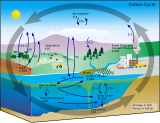
| Part of a series on the |
| Carbon cycle |
|---|
 |
Dissolved organic carbon (DOC) is the fraction of organic carbon operationally defined as that which can pass through a filter with a pore size typically between 0.22 and 0.7 micrometers.[2] The fraction remaining on the filter is called particulate organic carbon (POC).[3]
Dissolved organic matter (DOM) is a closely related term often used interchangeably with DOC. While DOC refers specifically to the mass of carbon in the dissolved organic material, DOM refers to the total mass of the dissolved organic matter. So DOM also includes the mass of other elements present in the organic material, such as nitrogen, oxygen and hydrogen. DOC is a component of DOM and there is typically about twice as much DOM as DOC.[4] Many statements that can be made about DOC apply equally to DOM, and vice versa.
DOC is abundant in marine and freshwater systems and is one of the greatest cycled reservoirs of organic matter on Earth, accounting for the same amount of carbon as in the atmosphere and up to 20% of all organic carbon.[5] In general, organic carbon compounds are the result of decomposition processes from dead organic matter including plants and animals. DOC can originate from within or outside any given body of water. DOC originating from within the body of water is known as autochthonous DOC and typically comes from aquatic plants or algae, while DOC originating outside the body of water is known as allochthonous DOC and typically comes from soils or terrestrial plants.[6] When water originates from land areas with a high proportion of organic soils, these components can drain into rivers and lakes as DOC.
The marine DOC pool is important for the functioning of marine ecosystems because they are at the interface between the chemical and the biological worlds. DOC fuels marine food webs, and is a major component of the Earth's carbon cycling.[7]
- ^ Roshan, S. and DeVries, T. (2017) "Efficient dissolved organic carbon production and export in the oligotrophic ocean". Nature Communications, 8(1): 1–8. doi:10.1038/s41467-017-02227-3.
- ^ "Organic Carbon". Bio-geochemical Methods. Retrieved 27 November 2018.
- ^ Kenny, Jonathan E.; Bida, Morgan; Pagano, Todd (October 2014). "Trends in Levels of Allochthonous Dissolved Organic Carbon in Natural Water: A Review of Potential Mechanisms under a Changing Climate". Water. 6 (10): 2862–2897. doi:10.3390/w6102862.
- ^ Moody, C.S. and Worrall, F. (2017) "Modeling rates of DOC degradation using DOM composition and hydroclimatic variables". Journal of Geophysical Research: Biogeosciences, 122(5): 1175–1191. doi:10.1002/2016JG003493.
- ^ Hedges, John I. (3 December 1991). "Global biogeochemical cycles: progress and problems" (PDF). Marine Chemistry. 39 (1–3): 67–93. doi:10.1016/0304-4203(92)90096-s.
- ^ Kritzberg, Emma S.; Cole, Jonathan J.; Pace, Michael L.; Granéli, Wilhelm; Bade, Darren L. (March 2004). "Autochthonous versus allochthonous carbon sources of bacteria: Results from whole-lake 13C addition experiments" (PDF). Limnology and Oceanography. 49 (2): 588–596. Bibcode:2004LimOc..49..588K. doi:10.4319/lo.2004.49.2.0588. ISSN 0024-3590. S2CID 15021562.
- ^ Lønborg, C., Carreira, C., Jickells, T. and Álvarez-Salgado, X.A. (2020) "Impacts of global change on ocean dissolved organic carbon (DOC) cycling". Frontiers in Marine Science, 7: 466. doi:10.3389/fmars.2020.00466.
 Material was copied from this source, which is available under a Creative Commons Attribution 4.0 International License.
Material was copied from this source, which is available under a Creative Commons Attribution 4.0 International License.